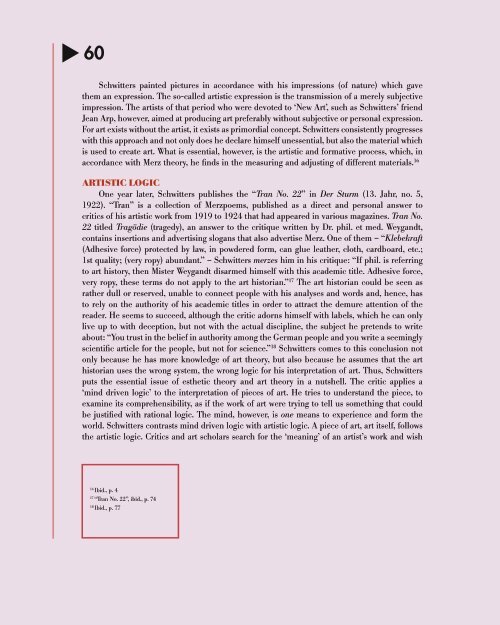Kurt Schwitters: Merz (2016) – Norman Rosenthal interviews Damien Hirst
Fully illustrated catalog published by Galerie Gmurzynska in collaboration with Cabaret Voltaire Zurich on the occasion of Kurt Schwitters: MERZ, a major retrospective exhibition celebrating 100 years of Dada. The exhibition builds and expands on the gallery’s five decade long exhibition history with the artist, featuring exhibition architecture by Zaha Hadid. Edited by Krystyna Gmurzynska and Mathias Rastorfer. First of three planned volumes containing original writings by Kurt Schwitters, historical essays by Ernst Schwitters, Ad Reinhardt and Werner Schmalenbach as well as text contributions by Siegfried Gohr, Adrian Notz, Jonathan Fineberg, Karin Orchard, and Flavin Judd. Foreword by Krystyna Gmurzynska and Mathias Rastorfer. Interview with Damien Hirst conducted by Norman Rosenthal. Includes full color plates and archival photographs. 174 pages, color and b/w illustrations. English. ISBN: 978-3-905792-33-1 The publication includes an Interview with Damien Hirst by Sir Norman Rosenthal about the importance of Kurt Schwitters's practice for Hirst's work.
Fully illustrated catalog published by Galerie Gmurzynska in collaboration with Cabaret Voltaire Zurich on the occasion of Kurt Schwitters: MERZ, a major retrospective exhibition celebrating 100 years of Dada. The exhibition builds and expands on the gallery’s five decade long exhibition history with the artist, featuring exhibition architecture by Zaha Hadid.
Edited by Krystyna Gmurzynska and Mathias Rastorfer.
First of three planned volumes containing original writings by Kurt Schwitters, historical essays by Ernst Schwitters, Ad Reinhardt and Werner Schmalenbach as well as text contributions by Siegfried Gohr, Adrian Notz, Jonathan Fineberg, Karin Orchard, and Flavin Judd.
Foreword by Krystyna Gmurzynska and Mathias Rastorfer.
Interview with Damien Hirst conducted by Norman Rosenthal.
Includes full color plates and archival photographs.
174 pages, color and b/w illustrations.
English.
ISBN:
978-3-905792-33-1
The publication includes an Interview with Damien Hirst by Sir Norman Rosenthal about the importance of Kurt Schwitters's practice for Hirst's work.
Create successful ePaper yourself
Turn your PDF publications into a flip-book with our unique Google optimized e-Paper software.
t<br />
60<br />
<strong>Schwitters</strong> painted pictures in accordance with his impressions (of nature) which gave<br />
them an expression. The so-called artistic expression is the transmission of a merely subjective<br />
impression. The artists of that period who were devoted to ‘New Art’, such as <strong>Schwitters</strong>’ friend<br />
Jean Arp, however, aimed at producing art preferably without subjective or personal expression.<br />
For art exists without the artist, it exists as primordial concept. <strong>Schwitters</strong> consistently progresses<br />
with this approach and not only does he declare himself unessential, but also the material which<br />
is used to create art. What is essential, however, is the artistic and formative process, which, in<br />
accordance with <strong>Merz</strong> theory, he finds in the measuring and adjusting of different materials. 16<br />
ARTISTIC LOGIC<br />
One year later, <strong>Schwitters</strong> publishes the “Tran No. 22” in Der Sturm (13. Jahr, no. 5,<br />
1922). “Tran” is a collection of <strong>Merz</strong>poems, published as a direct and personal answer to<br />
critics of his artistic work from 1919 to 1924 that had appeared in various magazines. Tran No.<br />
22 titled Tragödie (tragedy), an answer to the critique written by Dr. phil. et med. Weygandt,<br />
contains insertions and advertising slogans that also advertise <strong>Merz</strong>. One of them – “Klebekraft<br />
(Adhesive force) protected by law, in powdered form, can glue leather, cloth, cardboard, etc.;<br />
1st quality; (very ropy) abundant.” – <strong>Schwitters</strong> merzes him in his critique: “If phil. is referring<br />
to art history, then Mister Weygandt disarmed himself with this academic title. Adhesive force,<br />
very ropy, these terms do not apply to the art historian.” 17 The art historian could be seen as<br />
rather dull or reserved, unable to connect people with his analyses and words and, hence, has<br />
to rely on the authority of his academic titles in order to attract the demure attention of the<br />
reader. He seems to succeed, although the critic adorns himself with labels, which he can only<br />
live up to with deception, but not with the actual discipline, the subject he pretends to write<br />
about: “You trust in the belief in authority among the German people and you write a seemingly<br />
scientific article for the people, but not for science.” 18 <strong>Schwitters</strong> comes to this conclusion not<br />
only because he has more knowledge of art theory, but also because he assumes that the art<br />
historian uses the wrong system, the wrong logic for his interpretation of art. Thus, <strong>Schwitters</strong><br />
puts the essential issue of esthetic theory and art theory in a nutshell. The critic applies a<br />
‘mind driven logic’ to the interpretation of pieces of art. He tries to understand the piece, to<br />
examine its comprehensibility, as if the work of art were trying to tell us something that could<br />
be justified with rational logic. The mind, however, is one means to experience and form the<br />
world. <strong>Schwitters</strong> contrasts mind driven logic with artistic logic. A piece of art, art itself, follows<br />
the artistic logic. Critics and art scholars search for the ‘meaning’ of an artist’s work and wish<br />
16<br />
Ibid., p. 4<br />
17<br />
“Tran No. 22”, ibid., p. 74<br />
18<br />
Ibid., p. 77

















